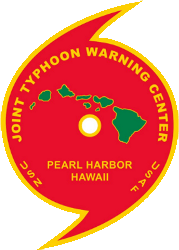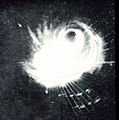Joint Typhoon Warning Center facts for kids
 |
|
| Agency overview | |
|---|---|
| Formed | May 1, 1959 |
| Headquarters | Pearl Harbor, Hawaii |
| Employees | 59 (2015) |
| Parent agency | United States Navy United States Air Force |
| Website | http://www.metoc.navy.mil/jtwc/ |
The Joint Typhoon Warning Center (JTWC) is a special group run by both the United States Navy and the United States Air Force. It's located in Pearl Harbor, Hawaii. Their main job is to give warnings about powerful storms called tropical cyclones. They cover huge areas like the North-West Pacific Ocean, South Pacific Ocean, and Indian Ocean.
These warnings help all parts of the U.S. military and other U.S. government groups. The warnings are super important for keeping military ships, planes, and bases safe. These bases are sometimes shared with other countries around the world. The Navy parts of the JTWC work closely with the Naval Meteorology and Oceanography Command.
Contents
History of the JTWC
The idea for the Joint Typhoon Warning Center started way back in June 1945. This was after several strong storms, like Typhoon Cobra in December 1944, caused many ships and people to be lost at sea. Because of these dangers, a group called the Fleet Weather Center/Typhoon Tracking Center was set up on the island of Guam.
How the JTWC Was Formed
In 1958, the U.S. military weather services and the National Weather Service decided to work together. They suggested creating a joint Navy and Air Force center. This new center would focus on understanding and predicting typhoons.
The top military leaders, known as the Joint Chiefs of Staff, approved the idea. So, on May 1, 1959, the Joint Typhoon Warning Center officially began. It was first led by the commander of the Fleet Weather Center.
Early Days and Challenges
When it first started, the JTWC had only ten people. Five were from the Navy and five from the Air Force. Their job was to give warnings for all tropical cyclones between the Malay Peninsula and the International Dateline. This covered a large area for U.S. government groups.
They also had to figure out what information was needed to track storms. They prepared yearly summaries of typhoons and did research to improve storm forecasting. In November 1962, a powerful storm named Typhoon Karen hit. It destroyed the building where the Fleet Weather Center and JTWC were located.
Moving and Growing
After the typhoon, the JTWC moved into a stronger, more storm-proof building in 1965. Between 1971 and 1976, the JTWC's area of responsibility grew much larger. It expanded to include the area from the International Dateline all the way to the coasts of Africa.
In October 1978, the center's name changed to the Navy Oceanographic Command Center/Joint Typhoon Warning Center. At this point, they became responsible for understanding the entire ocean environment. This included everything from the bottom of the ocean to the very top of the atmosphere.
Becoming an Independent Command
In October 2011, the JTWC's name changed again. It became simply the Joint Typhoon Warning Center. This was a big moment because it became a stand-alone command for the first time in its 52-year history. This meant it was no longer part of a larger command.
What the JTWC Does Today
Today, the Joint Typhoon Warning Center is staffed by about 37 people. These are dedicated members of the United States Air Force and the United States Navy. They work hard to keep people and property safe from powerful storms.
To do their job, the JTWC uses many advanced tools. They rely on different satellite systems and sensors to see storms from space. They also use radar, which helps them track storms closer to the ground. They collect data from the surface and upper parts of the atmosphere. All this information is fed into complex computer models. These models help them predict where storms will go and how strong they will become.
Images for kids
See also
 In Spanish: Centro Conjunto de Advertencia de Tifones para niños
In Spanish: Centro Conjunto de Advertencia de Tifones para niños


